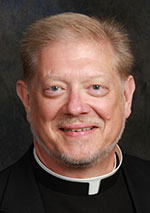That All May Be One / Fr. Rick Ginther
Directory on Ecumenism seeks to guide us on journey to unity
 How does the Catholic Church guide its bishops, pastors and lay leaders in the work of ecumenism? Good question.
How does the Catholic Church guide its bishops, pastors and lay leaders in the work of ecumenism? Good question.
Besides the essential documents from the Second Vatican Council and the writings of popes from St. John XXIII to Pope Francis, there is the Directory on Ecumenism.
Well, that’s the simple title. The actual one is: Directory for the Application of Principles and Norms on Ecumenism. It was published by the Pontifical Council for Promoting Christian Unity in 1993.
Why was such a document deemed necessary? And what questions does it answer for us?
By 1993, enough time had elapsed since the Second Vatican Council to have “under the Church’s belt” both positive and less than positive experiences and practices centered upon the work toward unity.
Questions from bishops, priests and others regarding ecumenical practices had been coming during the intervening years to the pontifical council.
These experiences and questions led to seeking the deeper principles to guide future ecumenical practices.
In addition, the publication of the Code of Canon Law for the Latin Church (1983), the Code of Canon Law for the Eastern Churches (1990) and the Catechism of the Catholic Church (1992)—each of which had sections focusing on ecumenism—argued for a revised document.
So a revision of the original two-part Ecumenical Directory (1967 and 1970) occurred.
As we have seen here in previous columns, subsequent progress in ecumenism has been made. The ecumenical movement has expanded. Many statements about dialogue have been published. Greater participation of the whole people of God has been encouraged.
This progress was encouraged and guided by the 1993 directory, which is “addressed to the pastors of the Catholic Church, but it also concerns all the faithful, who are called to pray and work for the unity of Christians, under the direction of their Bishops” (#4).
“The Directory intends to motivate, enlighten and guide [ecumenical] activity, and in some particular cases also to give binding directives” (#6).
The Directory also seeks to address “… a certain tendency to doctrinal confusion … and to avoid abuses which could either contribute to or entail doctrinal indifferentism [that is, that differences of religious belief are of no importance]” (ibid).
“The Directory begins with a declaration of the commitment of the Catholic Church to ecumenism [Chapter I.] This is followed by an account of the steps taken by the Catholic Church to put this commitment into practice, … through the organization and formation of its own members (Chapters II and III). It is to them … that the provisions of Chapters IV and V on ecumenical activity” … are laid out. (#7)
Within Chapter IV lie answers to questions concerning baptism: how we celebrate, what is considered a universally valid baptism, non-Catholic Christian as baptismal witnesses, etc.
Use of sacred spaces by various Christian communities are also addressed; how Christians may share in common prayer (days of recollection, spiritual exercises, groups for the study and sharing of traditions of spirituality); the question of limits to inter-communion; and mixed marriages, among others.
The actual document may be found online. Simply query “1993 directory on ecumenism.” Or if you would like a copy of the pdf, contact me at the archdiocesan Office of Ecumenism at 800-382-9836, ext. 1993.
(Father Rick Ginther is director of the archdiocesan Office of Ecumenism. He is also pastor of Our Lady of Lourdes Parish in Indianapolis.) †
 How does the Catholic Church guide its bishops, pastors and lay leaders in the work of ecumenism? Good question.
How does the Catholic Church guide its bishops, pastors and lay leaders in the work of ecumenism? Good question.